Why Do Salmon Run? And When?
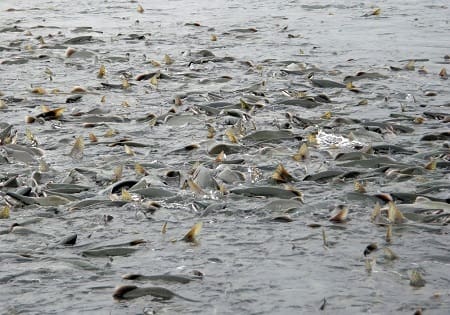
Salmon are a migrating species, and they are born in rivers and then migrate to an ocean or large lake to grow and mature. Once sexually mature, they return to the river to reproduce. This migration is often referred to as the “salmon run,”.
Why Do Salmon Run Up Rivers?
The reason salmon run up rivers to spawn is because the upper sections of rivers have highly oxygenated, clean, cold water and food sources better suited to the survival of the new-born salmon. The upper rivers also have less predation.
Other factors, such as concentrating mates and survival of the fittest may also contribute to the salmon run.
Some salmon die after they spawn, while others will spawn multiple times. For some salmon, the salmon run every year, but for other salmon species, the salmon run is every other year. Salmon will also run at different times which are all discussed here.
Key Takeaways
- Why Salmon Run: To reproduce and ensure offspring survival.
- Navigation Method: Utilizing Earth’s magnetic field and scent memory.
- Challenges: Many unknowns in the migration and spawning process.
- Salmon Run Frequency and When: Typically an annual occurrence.
- Feeding During the Run: Salmon significantly reduce or cease feeding.
- Duration of the Run: Can last several weeks to a couple of months.
- Night and Day Migration: Salmon run both during the day and at night.
- Fishing During the Run: Regulated to ensure sustainable salmon populations.
Why Do Salmon Run?
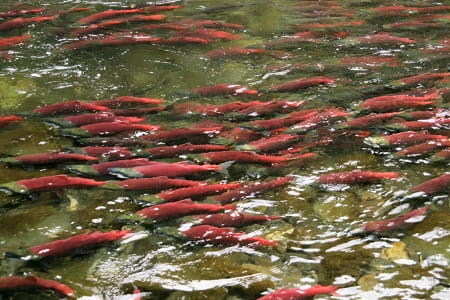
Salmon are driven by a potent biological imperative: to reproduce and safeguard their progeny’s survival. The natal streams and rivers, having successfully nurtured them, are the chosen venues for the next generation.
The journey upstream to their spawning grounds is challenging on the salmon, yet the survival of their species hinges on this arduous journey.
Ensuring Offspring Survival
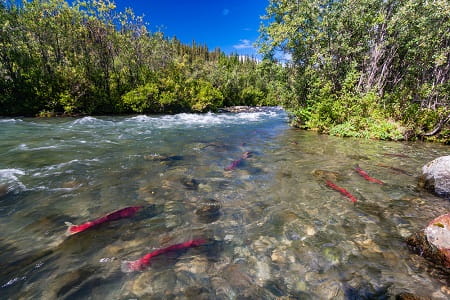
The choice to return to their birthplace is built into the adult salmon. These locations have proven to be successful spawning sites, offering the right conditions and the presence of mates of the same species.
By returning to these proven spawning grounds, the salmon enhance the survival odds of their offspring, perpetuating the cycle of life.
When Do The Salmon Run?
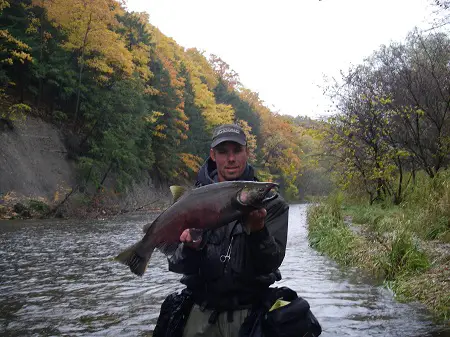
As a fishing guide for salmon, I know that the timing of the salmon run can vary depending on the species of salmon and the geographical location.
The salmon run can also depend on water flows and temperatures of the river, both could delay or start the runs early.
Here are some general timelines:
- Spring Run: March to July – Usually occurs in northern climates like Alaska.
- Summer Run: May to August – Common for Atlantic salmon and some Pacific Northwest Rivers.
- Fall Run: September to November – Common time on southern rivers and Great Lakes Salmon Rivers.
- Winter Run: November to February – It is rare for salmon to run at this time. However, in some parts of the world, it is possible.
Different species of salmon might run at different times. For example, in the Pacific Northwest of the United States:
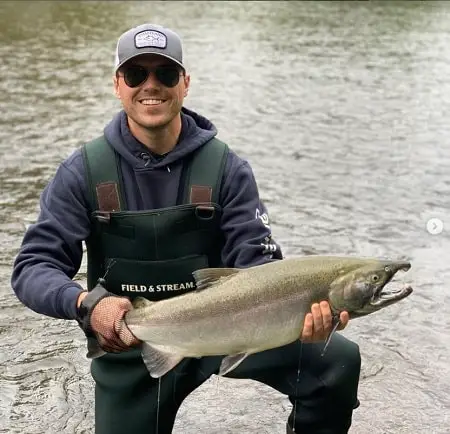
- Chinook Salmon: May to September
- Coho Salmon: September to November
- Sockeye, Pink Salmon, and Chum Salmon: June to October
In Alaska: See Salmon Fishing Alaska for more details.
- King Salmon: May to July
- Sockeye Salmon: June to July
- Silver Salmon: August to September
Great Lakes: See Salmon Fishing The Great Lakes for more details.
- Coho and King Salmon: September to November
- Atlantic Salmon: June to November
It’s essential to note that these are general timelines and the exact timing can vary year by year and be influenced by various environmental factors.
For specific and detailed information, it’s recommended to refer to local fisheries websites or government resources related to wildlife and fisheries in the particular region of interest.
You may also find information on the salmon runs through our website if you search salmon runs by state or province.
Another source of determining the salmon runs is to look at local fishing guide to see when they recommend to fish the rivers. The will fish during peak salmon run times.
Many people wonder how a salmon roaming around the vast ocean are able to not only find their way back to the same river they were born in but also get very close to the spot they were conceived.
Utilizing Earth’s Magnetic Field
In the vast, open ocean, salmon leverage the Earth’s magnetic field as a navigational guide, moving from coastal areas near their spawning grounds to affluent feeding areas and back again towards the end of their lives. This magnetic guidance is not learned but is an astonishing ability that appears to be genetically inherited.
Genetic Inheritance vs. Learned Behavior
While the magnetic guidance is inherited, salmon also exhibit learned behaviors, such as memorizing the scent of their home stream during their seaward journey. This scent memory plays a pivotal role when they return as adults, guiding them through familiar waters and stimulating their upstream journey.
The Olfactory Guide
Memorizing the Scent of Home
As young salmon migrate towards the ocean, they encode the unique scent of their home stream, creating a sensory map that will guide them back. This olfactory memory is crucial, acting as an invisible thread that pulls them back to where their journey began.
The Precision of Return
Salmon, despite the vastness of the ocean and the myriad of streams available, astonishingly find their way back to their exact birthplace.
This precision in their return journey has baffled scientists and researchers alike. While the mechanisms of magnetic fields and scent memory are understood, the exactitude of their return journey to their precise birthplace remains a fascinating mystery.
Frequently Asked Questions About the Salmon Run
What does it mean when the salmon are running?
When the salmon are running, it refers to their mass migration from the ocean back to their natal streams and rivers. This journey, known as the “salmon run,” involves the salmon traveling upstream to spawn, ensuring the survival and continuation of their species.
What is the salmon run, and why is it important?
The salmon run is the migration of salmon from the ocean to their spawning grounds in freshwater streams and rivers. It is crucial for the reproduction of salmon, ensuring that they spawn in environments that have proven to be successful for offspring survival.
How often do salmon runs happen?
Salmon runs typically happen annually. Different species of salmon may have their runs at different times of the year, usually occurring in the fall. Species like Pink Salmon run every other year.
Do salmon eat during the salmon run?
Salmon significantly reduce their feeding or may stop eating altogether during the salmon run. Their primary focus during this time is to reach their spawning grounds. The energy for this strenuous journey is derived from fat stores accumulated during their time in the ocean.
Do Salmon Bite During The Salmon Run?
A guide’s perspective is that, yes, salmon will bite during the salmon run. They have been known to bite while spawning. This is either out of aggression, instinct, habit, or for sustenance.
How long does a salmon run last?
The duration of a salmon run can vary widely depending on the species and the distance they must travel. Some salmon runs can last several weeks, while others may extend for a couple of months. Each species of salmon may also have different run timings.
Do Salmon Run At Night?
Yes, salmon can and do run at night, in fact on clear low rivers the salmon prefer to run during low light hours and at night. Salmon use the current to navigate up the river in the dark.
Do salmon run in the daytime?
Yes, salmon also run during the daytime however, in low clear water they may halt their migration and hold in deeper pools. Their migration is a continuous journey that involves both day and night travel to reach their spawning grounds in time.
Can you fish during the salmon run?
Yes, fishing during the salmon run is popular and legal in most areas. However, it is regulated to ensure that the salmon populations are not adversely affected and regulations vary based on location. Regulations may include specific seasons, locations, and types of salmon that can be fished.
Conclusion On When and Why Do Salmon Run?
The salmon run, is a phenomenal journey from the ocean back to the very birthplace, is a spectacular display of endurance, instinct, and survival strategy.
Salmon, through their incredible navigational skills, manage to traverse through vast and treacherous oceanic expanses, guided by the Earth’s magnetic field and the imprinted scent of their home stream, to return to their spawning grounds.
Tight Lines
Graham
Sources:
- NOAA Fisheries
- Source: NOAA Fisheries – Salmon
- Citation: NOAA Fisheries. “Salmon”. Retrieved from https://www.fisheries.noaa.gov/species/salmon.
- U.S. Fish & Wildlife Service
- Source: U.S. Fish & Wildlife Service – Pacific Region Fisheries
- Citation: U.S. Fish & Wildlife Service. “Pacific Region Fisheries”. Retrieved from https://www.fws.gov/fisheries/.
- Washington Department of Fish & Wildlife
- Source: Washington Department of Fish & Wildlife – Salmon & Steelhead Fishing
- Citation: Washington Department of Fish & Wildlife. “Salmon & Steelhead Fishing”. Retrieved from https://wdfw.wa.gov/fishing/regulations/salmon.
- Alaska Department of Fish and Game
- Source: Alaska Department of Fish and Game – Salmon
- Citation: Alaska Department of Fish and Game. “Salmon”. Retrieved from http://www.adfg.alaska.gov/index.cfm?adfg=fishingSportFishingInfo.main.
- California Department of Fish and Wildlife
- Source: California Department of Fish and Wildlife – Salmon and Steelhead
- Citation: California Department of Fish and Wildlife. “Salmon and Steelhead”. Retrieved from https://wildlife.ca.gov/Conservation/Fishes/Salmon-and-Steelhead.
